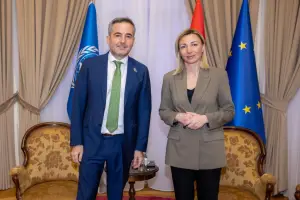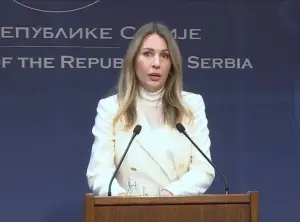Q:
A:
First certificates of the Beautiful Serbia project awarded
Belgrade,
28 April 2004
The first group of 75 trainees who successfully completed a three-month training programme in construction skills, as part of the Beautiful Serbia project of temporary employment and vocational training, received their certificates today, and seven of them will be immediately employed on the refurbishment of the Belgrade Library building. Deputy Minister of Labour, Employment and Social Affairs Vukojica Scekic said that the certificates awarded are the first visible result of the project, which will produce trained people who will carry out construction and other works on the refurbishment of Belgrade, Nis and Novi Sad.
Scekic said that the Beautiful Serbia project provides concrete and direct support to the Ministry's efforts to provide jobs for the unemployed and those who will lose their jobs in the upcoming transition processes.
He said that this project offers many possibilities for training and employment of those who are looking for a job, adding that such ideas will create new methods for the reduction of unemployment in Serbia.
The Deputy Minister said that new trainees will soon get certificates as well, adding that there will be many more people who will obtain training for construction and other works through this project.
Beautiful Serbia is a project of temporary employment and vocational training, implemented by the Serbian Ministry of Labour, Employment and Social Affairs, with the support of the United Nations Development Project (UNDP). The project is also financed by the Canadian government, through the Canadian International Development Agency (CIDA), as well as the Dutch and Austrian governments. The Serbian Ministry of Labour, Employment and Social Affairs and the cities of Belgrade, Nis and Novi Sad, in which the project is being carried out, also significantly contributed to the project's budget, which totals $2 million at the moment.
Deputy of the UNDP resident representative to Serbia-Montenegro Garret Tankosic Kelly said that the Beautiful Serbia project was launched as part of the Poverty Reduction Strategy. He told the trainees who completed the three-month training programme that their certificates can help them find permanent employment as well.
Dutch Ambassador to Serbia-Montenegro Barend van der Heijden said his country is financing this project, which is to be implemented in Belgrade and Nis, and voiced satisfaction with the fact that buildings in these two cities would be refurbished, because those who are to work on it would also benefit.
Austrian Ambassador Hannes Porias said the implementation of this project has two main goals, those being to help unemployed people and improve the appearance of Serbia’s cities. He added that Austria had supported a similar project in some 100 towns in Bulgaria, which helped the country’s economy. Austria has provided funds for the part of the project carried out in Nis and Novi Sad.
Programme officer of the Canadian International Development Agency (CIDA) Srdjan Svircev said the biggest merit of this programme is that it would help people to find jobs.
The aim of Beautiful Serbia is to alleviate unemployment impact of transition until conditions are created for a sustainable development and until Serbia’s economy is able to generate new jobs. The project includes vocational training in construction skills for long-term unemployed people registered in the National Employment Service in the beneficiary cities. The most vulnerable groups, such as refugees, internally displaced people, and the Roma, will take priority in this project. These people will get temporary jobs in firms involved in Beautiful Serbia.
The project will provide vocational training for long-term unemployed people, and improve quality of life in the beneficiary cities, improve the appearance and living environment. The project will also strengthen municipal capacities for the implementation of national labour market policies.
Beautiful Serbia is a replication of the successful UNDP-supported Beautiful Bulgaria and programme currently implemented in 102 Bulgarian municipalities.
He said that this project offers many possibilities for training and employment of those who are looking for a job, adding that such ideas will create new methods for the reduction of unemployment in Serbia.
The Deputy Minister said that new trainees will soon get certificates as well, adding that there will be many more people who will obtain training for construction and other works through this project.
Beautiful Serbia is a project of temporary employment and vocational training, implemented by the Serbian Ministry of Labour, Employment and Social Affairs, with the support of the United Nations Development Project (UNDP). The project is also financed by the Canadian government, through the Canadian International Development Agency (CIDA), as well as the Dutch and Austrian governments. The Serbian Ministry of Labour, Employment and Social Affairs and the cities of Belgrade, Nis and Novi Sad, in which the project is being carried out, also significantly contributed to the project's budget, which totals $2 million at the moment.
Deputy of the UNDP resident representative to Serbia-Montenegro Garret Tankosic Kelly said that the Beautiful Serbia project was launched as part of the Poverty Reduction Strategy. He told the trainees who completed the three-month training programme that their certificates can help them find permanent employment as well.
Dutch Ambassador to Serbia-Montenegro Barend van der Heijden said his country is financing this project, which is to be implemented in Belgrade and Nis, and voiced satisfaction with the fact that buildings in these two cities would be refurbished, because those who are to work on it would also benefit.
Austrian Ambassador Hannes Porias said the implementation of this project has two main goals, those being to help unemployed people and improve the appearance of Serbia’s cities. He added that Austria had supported a similar project in some 100 towns in Bulgaria, which helped the country’s economy. Austria has provided funds for the part of the project carried out in Nis and Novi Sad.
Programme officer of the Canadian International Development Agency (CIDA) Srdjan Svircev said the biggest merit of this programme is that it would help people to find jobs.
The aim of Beautiful Serbia is to alleviate unemployment impact of transition until conditions are created for a sustainable development and until Serbia’s economy is able to generate new jobs. The project includes vocational training in construction skills for long-term unemployed people registered in the National Employment Service in the beneficiary cities. The most vulnerable groups, such as refugees, internally displaced people, and the Roma, will take priority in this project. These people will get temporary jobs in firms involved in Beautiful Serbia.
The project will provide vocational training for long-term unemployed people, and improve quality of life in the beneficiary cities, improve the appearance and living environment. The project will also strengthen municipal capacities for the implementation of national labour market policies.
Beautiful Serbia is a replication of the successful UNDP-supported Beautiful Bulgaria and programme currently implemented in 102 Bulgarian municipalities.











